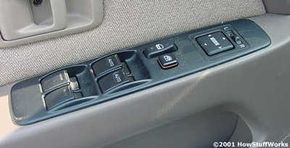Simplified Wiring
Multiplexing is a technique that can simplify the wiring in a car. In older cars, the wires from each switch run to the device they power. With more and more devices at the driver's command each year, multiplexing is necessary to keep the wiring from getting out of control. In a multiplexed system, a module containing at least one microprocessor consolidates inputs and outputs for an area of the car. For instance, cars that have lots of controls on the door may have a driver's-door module. Some cars have power-window, power-mirror, power-lock and even power-seat controls on the door. It would be impractical to run the thick bundle of wires that would come from a system like this out of the door. Instead, the driver's-door module monitors all of the switches.
Here's how it works: If the driver presses his window switch, the door module closes a relay that provides power to the window motor. If the driver presses the switch to adjust the passenger-side mirror, the driver's door module sends a packet of data onto the communication bus of the car. This packet tells a different module to energize one of the power-mirror motors. In this way, most of the signals that leave the driver's door are consolidated onto the two wires that form the communication bus.
Advertisement
The development of new safety systems has also increased the number of microprocessors in cars. We'll talk about this in the next section.
